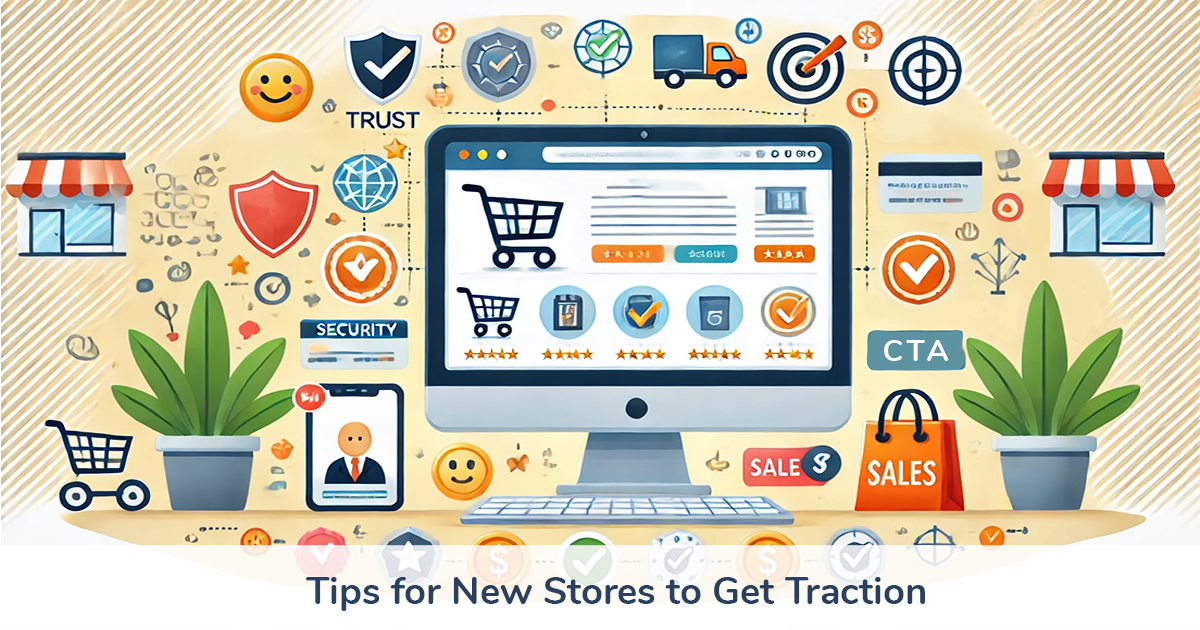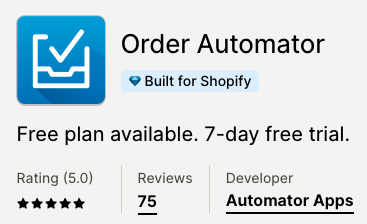
How to Figure Out Why You're Not Getting Sales on Shopify
March 28, 2024
Intro
This question comes up all the time in the Shopify forums.
I know first-hand the frustration of trying to get traction on a new store, and also grinding through the growth stages.
I owned a Shopify store for 7 years (also sold on 4 Amazon marketplaces, wholesale, and a little on other ecommerce platforms like Etsy, eBay, etc).
I've worked in the Shopify ecosystem for 10+ years doing development, marketing, management, and consulting. I'm a regular participant in the Shopify forums and a certified Shopify Expert (here's my Shopify community profile).
Summary
If you're getting traffic to your site but people aren't buying with at least a .5% conversion rate, it means one of 3 things:
- They don't trust your site
- They don't want to buy your product
- They don't believe it's a good value
If you want to have a successful store you're going to want to create a real brand, reason for existing, give a professional presentation to the people visiting your site, and ideally make an emotional connection with your customers.
And then make sure the traffic you're driving / attracting are your target audience.
The tips below can help your conversion rate no matter where you're at. Scan the checklist to see if there's something that you could improve on your site.
In this guide
Analyzing the Quality of Your Traffic
Starting with a quick note about traffic quality because it's essential, but often overlooked... it's a common mistake for someone without digital marketing experience to just put up some social media ads and hope for the best.
Aside from having a professional looking site and good products, it is essential to have quality traffic coming to your site.
Visitors with buyer intent (coming sources like Google Shopping, email, referral) almost always convert better than social media traffic.
Unless you have a viral product or an expert marketer creating targeted ads, Google Ads, email, and referral traffic are your best bet to maximize your conversion rate.
If you have a good product(s) then hiring a professional marketer should net a positive ROI investment. If you don't want to hire yet for marketing, I recommend focusing first on those 3 higher converting sources.
Checklist: Common Problems + Solutions
✅ Is your site trustworthy?
And non-spammy? If you have immediate popups, aggressive sales tactics, or create a fake sense of urgency, fake sales markdowns, you may be turning people away. Some of these more aggressive tactics can work once you have an established brand and community, but just starting out, if you have no social media following, little real product reviews, and an unknown brand, it's pretty easy for someone visiting your site to see these tactics as just that, sales tactics.
Don't judge yourself, send it to 10 - 20 people and ask for feedback. See if anyone wants to buy anything. If not, ask why. One on one feedback is huge at the start especially. Ask people you know and people you don't know, ask for constructive criticism, let them know that honesty will help you more than compliments or congratulations.
✅ Do you have a professionallly designed logo?
Did you design your logo yourself or grab a cheap graphic? Or do you have only text?
If yes on any of those, it's time to get serious about your business and create your identity.
I've launched a variety of businesses in my career, sometimes I hire designers, but if I don't really have a clear idea for the design, I do a design contest on 48 Hours Logo.
This is a fun and solid way to get a professional logo for your brand. I started and a few years later sold a Shopify optimization and web development agency called Speed Boostr (check them out if you want to optimize your website). I built a brand, team, community, and trustworthy website. I used 48 Hours Logo to create the branding. Selling the company lends proof to the success of the brand experience, and it all started with the logo that identified the brand.
✅ Do you have a good about page?
🔑 Create an About page and put a link to the page in your main menu.
Give your brand some personality. People don't just buy products, they buy based on feelings and make emotional decisions.
Create an emotional connection with your customers, explain why you're different / unique / why they should buy from you, etc.
Add images and video. Be different, standout, give them a reason to contact you or want to be your customer.
✅ Do you have a mission?
Does your store exist just to make you money? That doesn't really provide value to people. It's easy to get a wide variety of products people on Amazon. Be different, create value, have a good reason for existing.
I see this a lot: "We sell quality products at a fair price". This is not a mission or reason for existing, it's a generic phrase, an expectation that every customer has for the products they buy.
Here's an exercpt from a mission I had on 1 of my brands: "We're on a mission to plant a million trees and make a positive impact in the world". It worked because we focused on eco friendly materials, planted a tree on every sale, and promoted hiking, camping, and outdoor adventures. We connected with our audience, people that want to make more concious purchase decisions, care about the planet, and have sense of adventure.
Spend some time thinking about what higher cause your business can have for existing. Giving back is great in so many ways, I would try and work something like that into your business.
✅ Do you have product reviews?
If not, send out some free samples to get reviews, or ask people to make a purchase, give feedback, and leave a review. Reach out to social media influencers in your niche, ask them to try your product, for free, and if they like it all you ask is for a review and a picture with the product, and a post if they are inclined. You'll get more takers if you don't pressure them... if they decide not to post something, just ask for honest feedback, and call that the cost of intelligence gathering to get true insights on your products / brand that you can then improve.
If you don't have a reviews app, or are just using a basic app, I recommend trying Judge.me. It's the app I used on all my stores, the best reviews app for Shopify (I tried a bunch), and has features that can generate more sales, making it a positive ROI investment (it's low cost anyway).
✅ Do your products make sense together? Or do you have a mini everything store of random products?
It's ok to only have a few products, or even 1 product, easier to market actually.
But if you sell men's t-shirts, baby clothes, novelty items, and water bottles all on the same site (this example is pulled from a site I reviewed), it doesn't make logical sense to a shopper. Why would they buy random products from you instead of just going to Amazon?
You can't compete with Amazon, so focus on your niche and branding experience, give people value for coming to your site.
✅ Do you have images and videos showcasing your product?
Images with people using your product are huge for increasing conversion rate.
They also show you have a real brand, make your site more trustworthy, and build a sense of community.
If you don't have pictures of people using your products, you risk looking like a random dropshipping site.
I employed this strategy successfully on Shopify stores using the app Covet Pics:
-
Use Covert Pics app to put widgets on your product pages and collection pages that show gallery of tagged Instagram photos
-
Post photos to your own Instagram account and tag them accordingly to show up on those pages
-
Create an Instagram Shop page showing all of your tagged products and drive traffic to that page
-
Reach out to influencers and affiliates, offer them a free product in exchange for a permanent Instagram post (that you'll then tag and have show on your website)
A lot (maybe most) of brands don't have videos of their products. Make videos showcasing the product benefits, how to use it, etc. Promote these and make it easy for people to understand your product.
This improves trust too, because a typical scam site isn't going to invest the time and money to create a video, show their face, and develop a connection with customers.
I recommend trying Covet Pics and run the strategy I mentioned, or at least contact them and ask about that strategy, share those steps with them to ask how that can help your business.
✅ How are your copywriting skills?
If you're not a native English speaker, you 100% want to hire someone for copywriting, or at the very least to proofreed. When answering the question "why am I not getting any sales", I'm surprised to find a decent percent of people have spelling and grammar errors.
It's ok to sell in a different language, but understand that if you want to maximize the conversion rate and appear trustworthy, you need to have good copywriting from a native speaker.
If you're a native speaker of the language you sell in, it's still worth hiring a copywriter, at least for a consultation, to help develop a strategy on how to connect with your audience in a fluid way and lead them toward purchasing in an honest, natural way.
If you don't want to hire a copywriter, be passionate about your brand and products, be yourself, let your personality shine through on your website. Don't worry about corporate boring text. Be you, be unique and show people what's great about your brand and why you think they'll love your products and your mission.
✅ Does your domain name make sense?
If you're not on a .com, buy a .com. It's what people expect for online shopping.
Have a memorable domain name that matches with your branding. I've spent months thinking of a domain name before, on projects, and it's paid off many times. Branding is key and will be with you for the life of the business.
✅ Have you studied design or hired a designer?
Hire a web designer or conversion rate optimization consultant to help style out your site. Or at the very least buy a professional theme (the themes I've built Shopify sites from the most are from Out of the Sandbox. Excellent themes that require little customization out of the box for a great website.
Hiring either of those people will help you to match colors, give key tips based on best practices (like make your CTA a different color than anything else on the page), and develop a fluid strategy for presenting your brand in the best light.
If you're not hiring, take some time to learn online (courses, articles, you tube videos, books). It will pay off.
One of my favorite books on design for web usability is Don't Make Me Think.
✅ Have you asked for feedback from multiple sources?
Don't go by what you think. You have to ask around. Ideally to people that are your "perfect customer" / target audience.
But also:
-
Share your site link in the Shopify forums and ask for feedback
-
Ask family and friends what could be improved, tell them honesty will help you be more successful
-
Ask random people, anyone you interact with (networking events, collaborators, the random person sitting next to you on the train / bar, etc)
⭐️ Action Step 1: Consult an expert to dial in your store
A professional storefront using best practices in ecommerce UX design is a key component of converting visitors to customers.
If you already have your site launched, I recommend hiring a Shopify expert for at least a day to give advice and help fine-tune your site to maximize conversion rate + see what kind of widgets / customizations you can add to improve the site.
Someone like Stephen's World, a Shopify expert that's built and worked on a lot of Shopify sites and was a former Shopify Guru, is a nice choice because the experience that comes from working on a lot of Shopify sites in multiple areas helps bring good ideas and best practices to the table.
I used to be a freelance Shopify developer and optimization specialist and built a lot of Shopify sites myself, and had clients from startups to large revenue stores. Years of experience trained me to see what works and what doesn't, and I could instantly spot things "wrong" with sites I consulted on. I don't work in this area anymore but that's why Stephen's World stands out to me, I know the value of experience and see that he has it + I like that he contributes in the Shopify forums to help others.
Other places to find Shopify related experts:
-
Shopify forums (try posting some questions and if you see good answers, message those people / check out their website)
-
Ask for recommendations from people you work with, whether it's developers, designers, social media managers, or marketers, they likely have people in their network that they work with or recommend, and can pass that on to you
When I first started out long ago in ecommerce I made the mistake of trying to do everything myself. Once I started hiring experienced professionals in each component of the business, I not only grew sales and leveld up the store but also gained a lot of knowledge and ideas that carried over to other areas of the business.
📡 Action Step 2: Set up Systems to Get Quality Traffic
Collect emails: Set up an email capture (I like Klaviyo) and offer a discount for signing up for the email. Create email marketing flows and capitalize on that free traffic.
Set up Google Shopping: If you need help with Google Shopping (setup, optimization, audits, etc) I'd hire a Google Merchant Center expert like FeedArmy, a Shopify forums contributor and qualified Google partner.
If you prefer to do things yourself, here are some helpful resources:
- The Ultimate Google Shopping Guide from the Shopify blog
- Google Merchant Center guides and Shopify specific articles from FeedArmy, the Google Shopping expert mentioned above
Set up a referral program: Referral Candy is a popular Shopify app for this. That link also has a youtube video on how to set up program.
After your program is live, invite influencers to join, reach out to blogs, and try to get people to write an article promoting your product / brand (this is much easier if you give them a free product and invite them to your affiliate program). Those links not only send you quality traffic, but also help your SEO rankings to gain more organic traffic.
Hire a marketer, when you're ready: This will put you ahead leaps and bounds. Once you start working with a marketer you'll understand marketing in your own niche. Focus on evergreen marketing campaigns, so if it doesn't work out long term with your hire, at least you'll have those assets to keep the system going.
My favorite marketing hire was an email marketer that we started out with for a couple months. He created email blasts, promotions, ideas to grow the list, and automated evergreen email flows that generated a positive ROI almost immediately. The software we used was Klaviyo, it's great!
Wherever you hire from (Upwork, Shopify Experts directory, Shopify forums, Google search, etc), make sure you ask for case studies. I also like to ask them what would be their first strategy to implement if I hired them, and what are the expected results. That will help you to make the decision on whether to give them a try. Start out with a 1 time campaign, or 1 month, to test them. If they're good, keep it going. If not, try another.
Experiment and set up systems: See Automation Tip #1 here in 7 Shopify Automation Tips to Level Up Your Shopify Store for a great way to get free traffic until there's a sale (pay per conversion). The other 6 tips are proven strategies I've used to help Shopify stores save time and / or improve their businesses.
⭐️ Final thought: Build a cool brand, always be experimenting, always be learning, and invest in apps and quality professionals.
Good luck out there! ✊
🧙♂️ If this post was useful and you'd like to help us out, please check out our apps Order Automator and Product Automator. Our apps help Shopify stores and staff save time and money. 😃
 Author: Joe
Author: Joe


